Gran Canaria or Fuerteventura: what's your dream destination?
Make the best choice for your ideal Canary escape!When picturing the Canary Islands, one instantly thinks of stunning beaches, natural wonders of volcanic origin, and a vibrant cultural life, all seemingly suspended in a state of perpetual spring. This is why, when it comes to choosing one of them for a sunny escape, things may get tricky. But, let’s say that you have managed to narrow down your options and you are now facing a pressing dilemma: Gran Canaria or Fuerteventura?
Both these islands are among the largest in the archipelago, and each promises countless sights and attractions. To make your choice easier, we've created this guide on what makes each unique, providing you with all the essential information to help you pick the one that fits your vibe and meets your expectations of a dream-like getaway. And once you decide, you can set your Canaries getaway in motion by booking your ferry tickets on Ferryhopper in just a few steps!
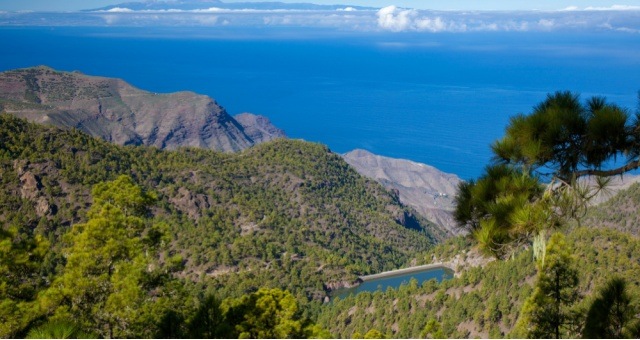
Breathtaking views from the slopes of Tamadaba Natural Park in Gran Canaria
Gran Canaria vs Fuerteventura: a tough dilemma
Gran Canaria and Fuerteventura share the same Canarian charm, yet still bring something distinctive to the table. For starters, Gran Canaria is often referred to as “the miniature continent” due to its diverse offerings. There are not many places in the world where you can wander through pine forests, explore volcanic valleys, and end up swimming off golden dunes by sunset, all within a single day. It’s an island made for those who appreciate variety and do not get easily overwhelmed by all the sights and options on display.
Fuerteventura, in contrast, moves to its own slower rhythm. Here, the main word is “beach”, as the island features some of the best in all of the archipelago, boasting almost 150 km of breathtaking coastline. Of course, it’s not all waves and turquoise waters, as Fuerteventura is also home to impressive natural attractions and has been designated a UNESCO Biosphere Reserve due to its diverse ecosystem.
Now that you have got a first impression of what sets Gran Canaria and Tenerife apart, keep on reading for the specifics to paint a complete picture of what each island has in store.
Beaches in Gran Canaria & Fuerteventura: which island takes the crown?
Life is a beach, goes a popular saying, and the Canary Islands are where this rings more true than anywhere else. The “beach contest” is where things get tricky when having to choose between Gran Canaria and Fuerteventura, because, frankly, there is some serious competition at play.
On the one hand, we have Gran Canaria, home to some of the biggest, busiest, and most popular beaches in the archipelago, located on the island’s south side, along with the wild and unspoiled wonders nested in its north and west sides. The first category is proudly represented by Las Canteras, which is next to the capital of Las Palmas and is often cited as "the best urban beach in the world" by Tripadvisor, and, of course, the 6 km long Maspalomas Dunes with its unique Sahara-style dunes. The second category boasts Güigüí, Gran Canaria's most famous remote and unspoiled beach, and one of our top 5 hidden gems in the Canary Islands, characterized by its black sand and crystal-clear waters.
Diversity may be Gran Canaria’s main trait in the beach department, but when it comes to sheer grandeur, it is Fuerteventura’s time to shine! Even picking the highlights among the more than 80 designated beaches on the island feels almost impossible. The Great Beaches of Corralejo, bordered by the Corralejo Dunes, the largest in the Canary Islands, are a piece of honey-colored sand heaven on Earth, while Esmeralda stuns with its emerald-green waters. And no mention of beaches in Fuerteventura is complete without Popcorn Beach, which is covered in small white algae fossils that look just like (you guessed it!) popcorn!
The verdict: Gran Canaria gets extra points for variety. But in terms of dramatic beauty, Fuerteventura takes the crown.
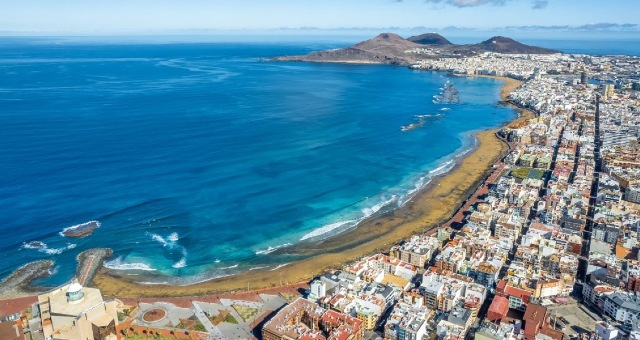
The famous Las Canteras urban beach in Las Palmas de Gran Canaria
Natural attractions in Gran Canaria & Fuerteventura: a battle of volcanic proportions!
Just when you thought that the beach debate would be the most challenging one, it's time to move on to the natural sights of Gran Canaria and Fuerteventura! Both islands cater to nature enthusiasts in abundance, so be sure to pack your hiking shoes and comfortable clothes, regardless of your choice, as you will likely want to take it all in.
Gran Canaria once again emerges as a playground of contrasts: from the emerald slopes of Tamadaba Natural Park to the panoramic views from the ridges of Nublo Rural Park, home to the 80-meter high volcanic rock of Roque Nublo, one of the island’s symbols, or the Fataga ravine, also known as the "Grand Canyon of Gran Canaria", the diversity on display here is awe-inspiring.
Less diverse but with a raw, elemental quality, nature in Fuerteventura may lack the dense forests and dizzying peaks of Gran Canaria, but its wide, wind-swept spaces create the effect of an otherworldly, desert-like landscape. The island’s volcanic craters, such as Calderón Hondo, are perfect for easy hikes of cinematic quality, and Corralejo Natural Park is a vast dune expanse that meets a glimmering coastline, a place that makes you feel as if you have stepped into your private oasis.
The verdict: Gran Canaria and Fuerteventura represent two sides of nature: one lush and varied, the other wild and open. Gran Canaria invites you to discover something new each day, while Fuerteventura lets you slow down and be amazed by the enduring effect of its volcanic origins.
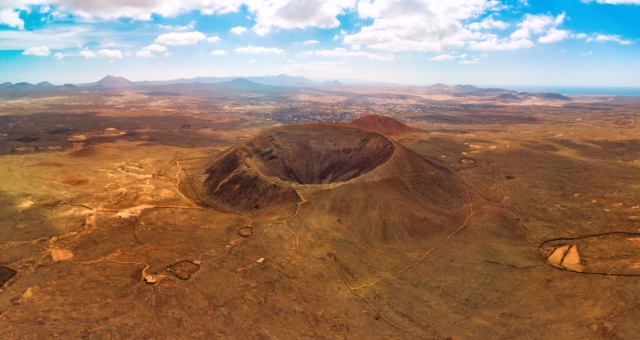
The dramatic beauty of Calderón Hondo crater in Fuerteventura
Cities and villages in Gran Canaria & Fuerteventura: which will you get to call home for a while?
If you want to combine the perks of urban living and big resorts with the intimate atmosphere of picturesque smaller towns and villages, then Gran Canaria is the obvious choice. Las Palmas de Gran Canaria, the capital of the island and the largest city in the Canary Islands, is a cosmopolitan hub where past meets present with ease. Mornings start with a stroll in the old quarter of Vegueta, with its cobbled streets, colonial buildings, and busy food and street markets, followed by a swim in the nearby Las Canteras Beach. Nights are all about having fun until well after midnight in one of the city’s many restaurants, bars, and clubs.
If you prefer the vibe of a resort to that of a big city, you can head to Maspalomas and Playa del Inglés, both popular choices due to their seaside locations and variety of amenities. Last but not least, Gran Canaria is home to many mountain and seaside villages, like Tejeda and Gàldar, where you will get a taste of authentic island living.
Fuerteventura may be the second-largest of the Canary Islands after Tenerife, but its capital, Puerto del Rosario, is considerably less busy than Las Palmas and is characterized by a creative and cultural spirit. Its streets are dotted with colorful murals and sculptures, small museums illuminate the island’s history, and the seafront is where locals and visitors mingle every day in its cafés, restaurants, and shops.
Further north, Corralejo is the island’s main tourist hub, with direct access to the spectacular Corralejo Dunes Natural Park and only a short boat ride away from the serene island of Los Lobos, a perfect day trip destination from Fuerteventura. Over on the east coast, Caleta de Fuste is a family favorite due to its calm, sheltered waters. Down south, you will find Morro Jable, nestled near the pristine beaches of the Jandía peninsula and the Jandía Natural Park, making it a haven for nature lovers and seekers of serenity.
The verdict: it’s a tie between Gran Canaria and Fuerteventura as both are renowned for their lively capitals, popular resort towns, and charming villages.
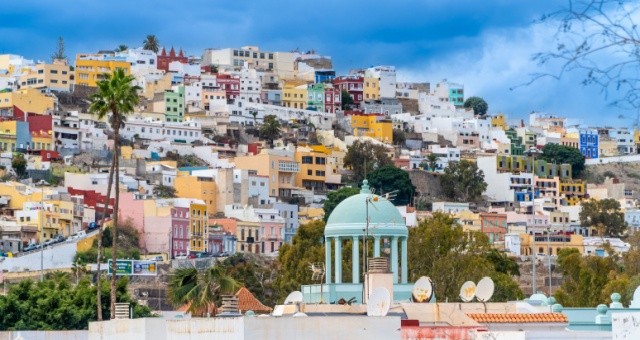
The colourful neighbourhood of Vegueta in Las Palmas de Gran Canaria
Food and culture in Gran Canaria & Fuerteventura: which one matches your taste?
On both Gran Canaria and Fuerteventura, the Canaries’ cultural and culinary traditions are ever-present.
For example, Gran Canaria’s capital, Las Palmas, may be world-famous for its beaches and nightlife, but history enthusiasts will be far from disappointed as it is dotted with beautiful monuments and museums such as Casa de Colón, a former mansion that housed Christopher Columbus during his expeditions. Meanwhile, Puerto del Rosario, the capital of Fuerteventura, leans towards the more artistic side, featuring over 100 sculptures by local and international artists.
There is also a notable difference in scope between the two islands in terms of cultural events. In Gran Canaria, these tend to be more large-scale, as exemplified by the Carnival of Las Palmas de Canaria (February), where costume parades and spontaneous parties erupt throughout the city, or Fiesta de la Rama in the town of Agaete (August 4th), where locals dance through the streets waving pine branches in honour of ancestral rain ceremonies.
On Fuerteventura, cultural events have a more intimate flair, such as the Fiesta de San Juan (June 23rd), celebrated on the island’s beaches with bonfires, fireworks, and fire-jumping rituals, or the Craft Fair of Antigua, which honors local artistry and craftsmanship and takes place several times throughout the year.
When it comes to food, both Gran Canaria and Fuerteventura share Canarian signature dishes, such as papas arrugadas (“wrinkled potatoes”) served with red or green mojo sauces, as well as ingredients like the roasted-grain flour known as gofio. However, each island has its own specialities.
On Gran Canaria, you’ll find dishes like ropa vieja (a stew with shredded meat, chickpeas, and potatoes), potaje de berros (watercress soup in the village of Firgas), and lapas con mojo (limpets with sauce).
Fuerteventura leans more into its goat-farming and fishing heritage: its star product is the queso majorero (goat-milk cheese), while dishes like sancocho (fish stew with potatoes) or pejines and jareas (sun-dried salted fish) reflect the island’s seafood tradition.
The verdict: Gran Canaria offers more diversity in terms of events and dishes, while Fuerteventura’s offerings stick to the more traditional side of things.
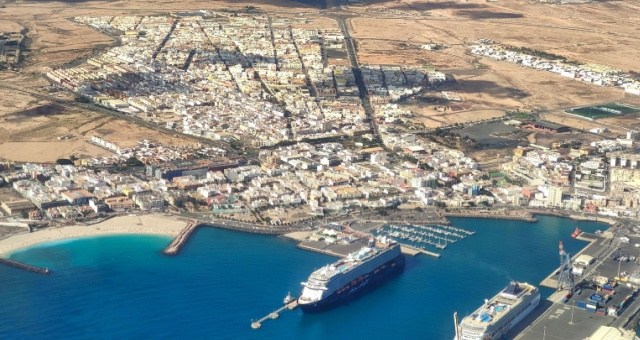
Puerto del Rosario: Fuerteventura's vibrant capital
Outdoor activities in Gran Canaria and Fuerteventura: a family-friendly haven or a surfer’s paradise?
Thanks to the famous climate of the Canary Islands, both Gran Canaria and Fuerteventura enjoy a spring-like climate throughout the year, making them prime choices for outdoor activities, such as hiking, kayaking, scuba diving, windsurfing, and even whale- or dolphin-watching.
Gran Canaria’s southern coast tends to be a bit warmer and more sheltered from the wind, offering many safe beaches and organized leisure options, which have earned the island its reputation as a more family-oriented destination. It is also renowned for its extensive network of cycling routes and hiking trails, which are perfect for exploring Gran Canaria's natural parks, pine forests, and picturesque villages.
Fuerteventura, with its flatter and more open terrain, is windier, making it perfect for water sports. More specifically, Fuerteventura is a quintessential surfer’s island, home to some of the best surf spots in the Canary Islands.
The verdict: Gran Canaria offers the ideal balance of comfort and adventure for the whole family, while Fuerteventura is a no-brainer for surf lovers.
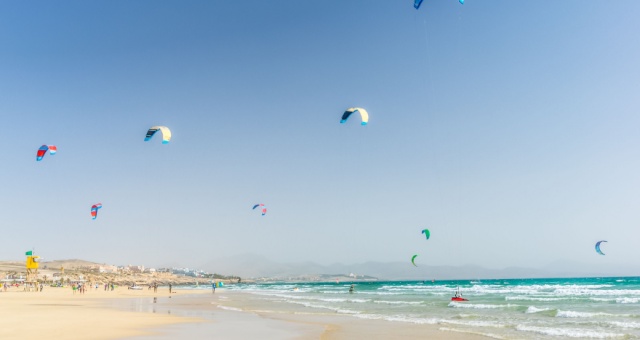
Playa De Sotavento in Fuerteventura: a kitesurfing paradise
So, what’s it gonna be: Gran Canaria or Fuerteventura?
If you‘ve made it this far, then you now hopefully have a good picture of what sets Gran Canaria and Fuerteventura apart, what makes each unique, and what the overall vibe and experiences you can expect. Of course, the choice will be made based on which one corresponds best to your idea of an unforgettable escape.
So, if you want a bit of everything, from beaches to hiking to nightlife, love contrasts, but you also wouldn’t mind spending a few days just relaxing at a top-notch resort, choose Gran Canaria. If you're looking for a more tranquil escape with fewer crowds, authentic flavors, and imposing volcanic landscapes, then Fuerteventura is calling.
And if you still cannot decide, why not give island hopping in the Canary Islands a try? Especially, when Gran Canaria and Fuerteventura are only 2 to 7 hours apart by ferry, with up to 5 daily crossings connecting the islands throughout the year! Check out all the routes from Gran Canaria to Fuerteventura and the Fuerteventura - Gran Canaria ferries, and why stick to one when you can enjoy both?
Extra tip: explore all active Canary Islands ferries for 2026 to discover the routes, expand your island-hopping itinerary, and find ideas for cross-Canary day trips!